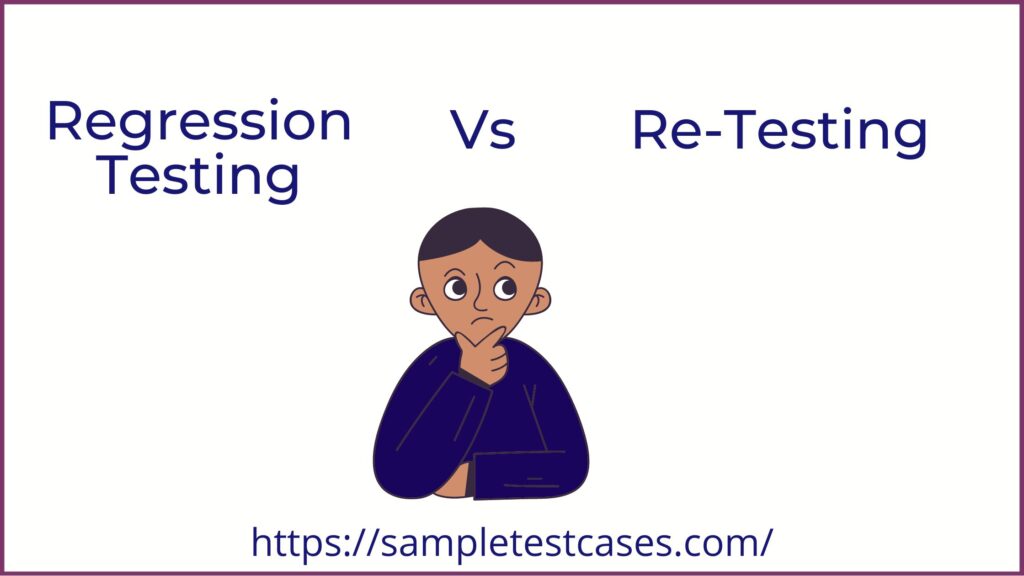In software testing, Retesting and Regression testing is mainly used for the improve the quality of the software products. So in this article, you will see the definition and difference between Regression Testing and Retesting.
What is Regression Testing In Software Testing?
When any kind of new functionality is added in the product, any defects have been fixed, any performance issue is fixed, any requirements are changed, then we are testing the application and ensure that it should not impact on the existing functionality. So, Its called as Regression Testing.
Regression Testing is an important testing in software testing field. It will help to improve product’s quality.
What is Retesting In Software Testing?
Re-Testing is one part of the Defect Life Cycle. When any defect is fixed by the development team then the defect goes into a retesting state where the tester is re-executed failed test cases and ensures that the original defect has been fixed or not.
In this article, we will discuss the Regression and Retesting Difference.
Difference Between Regression Testing And Retesting
| Regression Testing | Retesting |
| When adding a new feature or modifying feature, any defect or performance issue fixed then verifies that it should not impact on existing functionality. | Testing the failed test cases on the latest build for verifying that the previous defect is actually fixed or not is called re-testing. |
| It has not been mandatory to plan for regression testing. | It has to be required planning for re-testing. |
| It has lower priority compared to re-testing. | It has higher priority compare to regression testing |
| We can automate test cases for regression testing. | We cannot automate test cases for re-testing. |
| Regression testing can be done on Passed and Failed test cases. | Re-testing can be done only on failed test cases. |
Examples of Regression Testing and Retesting
Login Module – Test Cases
| Sr.No | Test Cases | Status |
| 1. | Users should be able to login with Valid Id and Password. | Fail |
| 2. | User should not be able to login with invalid ID and valid password | Pass |
| 3. | User should not be able to login with valid ID and invalid password. | Pass |
| 4. | User should not be able to login with blank fields. | Pass |
| 5. | User should not be login with blank ID and valid password. | Pass |
Defect Logged For TC – 1
Defect Title: User is not able to Login in the Admin module.
Re-Testing:
Now Tester will execute above failed test cases on the latest build for the previously failed test cases.
Tester will verify that below test cases is actual fixed or not on latest build.
If actual defect was fixed then status will mark as Pass.
| Sr.No | Test Cases | Status |
| 1. | User should be able to login with Valid Id and Password. | Pass |
Regression Testing Cycle :
Now as a tester will execute below all test cases and ensure that it will not impact on the existing functionality. [This will be caused by defect has been fixed. Same regression testing cycle will use if any new functionality has been added or any changed modifying or any performance issue fixed.]
| Sr.No | Test Cases | Status |
| 1. | User should be able to login with Valid Id and Password. | Pass |
| 2. | User should not be able to login with invalid ID and valid password | Pass |
| 3. | User should not be able to login with valid ID and invalid password. | Pass |
| 4. | User should not be able to login with blank fields. | Pass |
| 5. | User should not be login with blank ID and valid password. | Pass |
Conclusion:
So as shown above, we have discussed the difference between regression testing and retesting. It might be sometime confusing for new QA Testers. However, we have tried to make it simple for understand. We have explained with regression testing example and re-testing example. In most of the software testing interview, this difference is mostly asked by the interviewers. If you are also looking for more differences then please visit below link.
1.Functional And Non Functional Testing
2.Test Cases And Test Scenarios
3.Black Box Testing And White Box Testing
